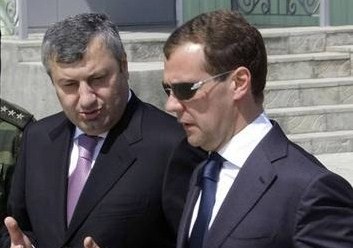
U.S. Foreign Policy Tested over Georgia
Publication: Eurasia Daily Monitor Volume: 6 Issue: 135
By:

Following U.S. President Barack Obama’s reaffirmation of political support for Georgia at the Moscow summit (EDM, July 14), and anticipating U.S. Vice-President Joseph Biden’s visit to Tbilisi, Russian President Dmitry Medvedev inspected the occupied South Ossetia on July 13. Medvedev made clear that the Russian military was digging in for a long-term presence there (Interfax, July 13).
It would hardly be surprising if Medvedev or Prime Minister Vladimir Putin were also to inspect the Russian-occupied Abkhazia, just before or (more likely) just after Biden’s visit to Tbilisi. Meanwhile, the U.S. Navy’s guided-missile destroyer U.S.S. Stout laid anchor in Batumi on July 14, the latest in the periodic U.S. flag-showing naval visits to Georgia (Rustavi-2 TV, July 14).
As this sequence suggests, the Obama administration may be ripening to a more consistent pursuit of strategic interests in Georgia and the region after the Bush 2008 rout. For its part, Moscow is reinforcing the iron curtain it has created around Georgia’s occupied territories.
It befalls to the Obama administration to operationalize the U.S.-Georgia Charter of Strategic Partnership, which was signed in early January 2009 as a framework document and bequeathed to the incoming administration for practical implementation. The charter envisages U.S. military assistance to strengthen Georgia’s security and improve the interoperability of its armed forces with those of NATO allies. It also opens wide possibilities for bilateral trade as well U.S. economic assistance to reward Georgia’s free-market reforms. Biden’s visit will serve to measure U.S. seriousness of purpose in implementing the signed charter.
Georgia, Europe, and Russia will all watch Biden’s visit to gauge the level of U.S. support for Georgia’s NATO aspirations. While Georgia’s preparations to meet membership criteria are handled multilaterally through the NATO-Georgia Commission and the Annual National Plan (ANP), the scope and pace of that process is a political matter. The United States, as the main political trend-setter in the Alliance, has a made-to-order opportunity during the Vice-President’s visit to clarify the Obama Administration’s support for Georgia’s goal of NATO membership. In parallel with the ANP and Commission processes, the United States is uniquely placed to equip and train Georgian forces for interoperability with NATO allies. Any presence of U.S. instructors on the ground would also serve as practical confirmation of President Obama’s recent words in Moscow that the United States does not accept spheres of influence and vetoes on a country’s choice of alliances (Interfax, July 7).
The primary focus of U.S. training and equipping must, however, shift from expeditionary counter-insurgency and peacekeeping to homeland defense operations. Such a correction is topical even for some NATO member countries that are covered by Article Five in terms of allied defense. It is all the more topical for Georgia, which is not covered by allied commitments to the defense of its territory. The U.S. training’s misplaced focus, exclusively on counter-insurgency in distant theaters, left Georgia defenseless and wide open to Russian invasion in 2008. The United States incurred substantial collateral damage to its prestige and credibility for misreading the nature of threats and Russia’s intentions. A repeat invasion, while unlikely at this time, remains a fully plausible contingency. While Georgia is set to deploy a combat battalion in Afghanistan’s south, for no-caveat missions alongside U.S. forces, many countries will watch to determine whether the United States can address the national defense requirements of its strategic partner in Georgia fairly and effectively.
Georgia is an arena where Russia has torn to shreds the treaty on Conventional Forces in Europe (CFE). This situation will confront Vice-President Biden when he looks at Russian combat hardware just across the ceasefire lines during his visit. Given the Obama administration’s special emphasis on arms control agreements, it would be surprising if Biden does not take public notice of Russia’s wholesale breaches of the CFE treaty while in Georgia. Taking such public notice could also help Washington deflect suggestions of tolerating those breaches on the southern flank as a price for renegotiating a follow-up CFE treaty with Moscow.
Thanks in part to those treaty violations, Russia has since 2008 "resolved" the Abkhazia and South Ossetia conflicts through military force and ethnic cleansing. The European Union’s Monitoring Mission (EUMM), deployed since October 2008 on the Georgian side of the ceasefire lines, helps to defuse the potential for clashes and report reliably on incidents. Washington and the E.U. are now considering possibilities for the United States to join the EUMM on the ground. The technicalities may be politically complicated but the arrangement itself is clearly doable. U.S. participation could improve EUMM’s prospects to progress from its limited monitoring role to a policing role on both sides of the ceasefire lines, stabilize the military and social situations there, and begin preparations for the expellees’ safe return to their homes.




